#Valley of the Temples in Agrigento
Explore tagged Tumblr posts
Text
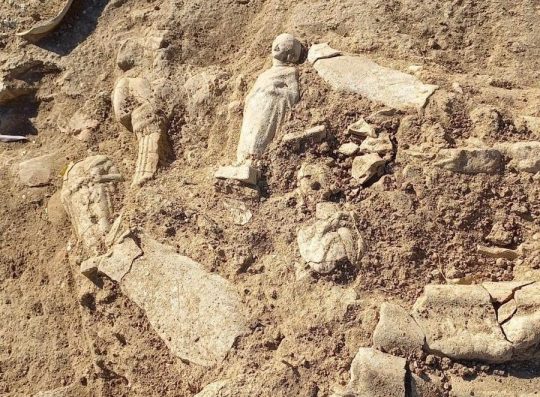
Rich Votive Deposit Discovered in Sicily's Valley of the Temples
At least sixty terracotta figurines, female protomes, and busts, oil lamps, and small vases, a rich votive deposit of bronze fragments were found in the Valley of the Temples in Agrigento, on the southwest coast of Sicily.
The objects were found in House VII b, which forms part of the housing complex north of the temple of Juno. The campaign is fully funded and supported by the Sicilian Region through the Valley of the Temples Archaeological Park, directed by Roberto Sciarratta, and is led by archaeologist Maria Concetta Parello.
In an announcement published by the Sicilian Region Institutional Portal: “The findings allow us to understand the dynamics of the destruction of Agrigentum in 406 BC by the Carthaginians, when the inhabitants had to flee in exodus towards the city of Gela.”
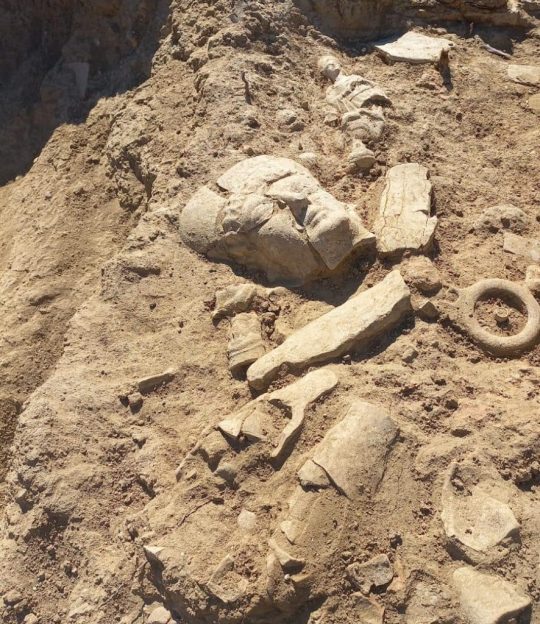
The votive deposit, which would appear to have been arranged above the destruction levels of the house, may tell the story of the time when its objects were recovered by the Akragantines after the destruction. To define with certainty the function of the interesting deposit will require further research, paying close attention to the stratigraphic connections between the deposit and the living and abandonment levels of the house.
The Valley of the Temples forms part of the ancient city of Agrigentum, situated in the province of Agrigento, Sicily. Since 1997, the Valley of the Temples (covering 3212 acres) has been included in the UNESCO World Heritage List.
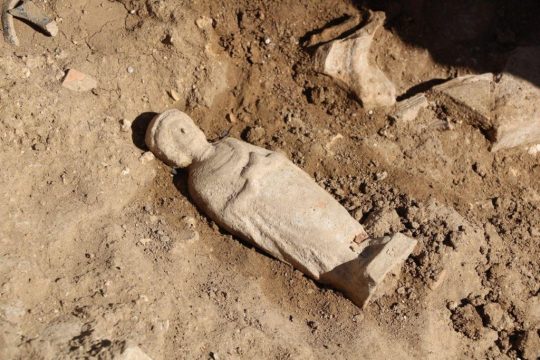
According to the Greek historian, Thucydides, Agrigentum was founded around 582-580 BC by Greek colonists from Gela in eastern Sicily, with further colonists from Crete and Rhodes. It was routed by the forces of Carthaginian general Himilko in 406 B.C. Agrigento’s residents fled to nearby Gela when Himilko sacked their city, but then he took Gela too. All of the Greek colonies on Sicily fell to Himilko and were made vassals of Carthage. Punic primacy would not last long, however. Timoleon of Corinth defeated Carthage in Sicily and liberated the Greek cities in 399 B.C.
By Leman Altuntaş.
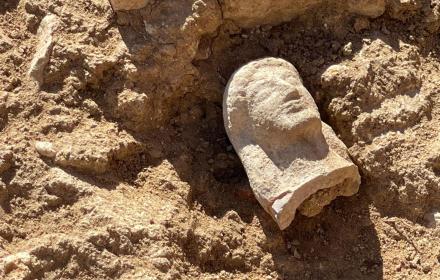
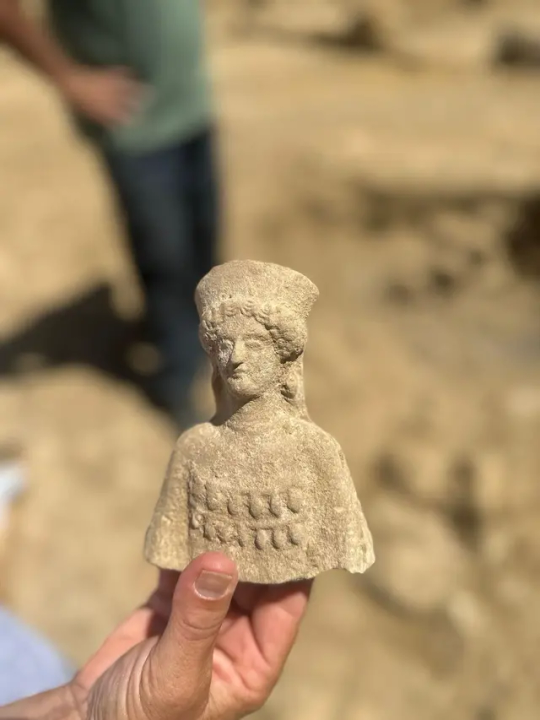

#Rich Votive Deposit Discovered in Sicily's Valley of the Temples#Valley of the Temples in Agrigento#temple of Juno#terracotta figurines#ancient artifacts#archeology#archeolgst#history#history news#ancient history#ancient culture#ancient civilizations#ancient sicily#ancient greece#greek history#greek art
274 notes
·
View notes
Text

Temple of Concordia, one of best preserved Ancient Greek temples in the world.
Agrigento, Italy
#agrigento#italy#italia#ancient greece#ancient greek#ancient ruins#ruins#temple#greek temple#valley of the temples#photography#original photography#travel#photographers on tumblr#lensblr#architecture#historical architecture#ancient architecture#wanderingjana#sicily#sicilia
116 notes
·
View notes
Text

Valle dei Templi (Valley of the Temples) in Agrigento, Sicilia, ITALIA
170 notes
·
View notes
Text






Valley of Temples, Italy.
#temple#greek mythology#greek gods#travel#sicily#italia#agrigento#valley of temples#la valle dei templi#history#dark academia#inspo#aesthetic
21 notes
·
View notes
Text

115 degrees on the rocks today at incredible Valle dei Templi. 🪨🌞🇮🇹
#sicily italy#Sicily#Sicilian#agrigento#valley of the temples#unesco#ancient rome#ancient greece#ancient greek mythology#greek gods#greek architecture#greek art#greek archaeology#archeology#ancient civilizations#art history#roman empire#Roman#zeus#greek mythology#italia#italian#travelgram#travel diaries#travel diary#travel journal#acropolis#parthenon#study abroad#ancient greek
9 notes
·
View notes
Text
Travel: Agrigento: Valley of the Temples & Villa Romano del Castle - S. Italy
Agrigento: Valley of the TemplesAgrigento, also known as Akragas, was one of the leading cities during the golden age of ancient Greece. Here we took a guided tour of the Valley of Temples. These ruins of Akragas make up Sicily’s most amazing archeological site. Entire area with 1300 hectares is a United world heritage site. It is huge and shows the glory of ancient Greek art and…
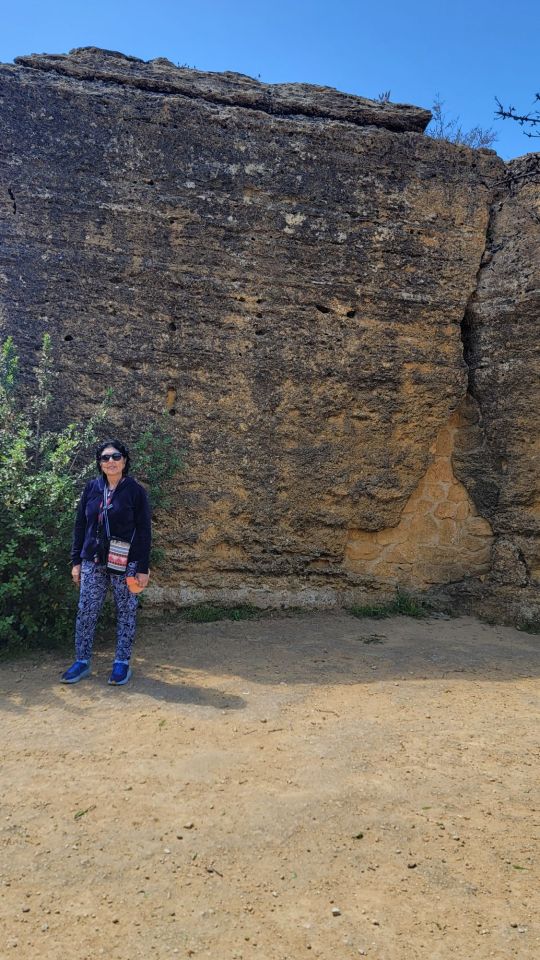
View On WordPress
#Agrigento#Globus Tours#https://bit.ly/3FGNGlJ#Italy off the beaten path#Souther Italy#Valley of the Temples#Villa Romano Del Castel
0 notes
Text
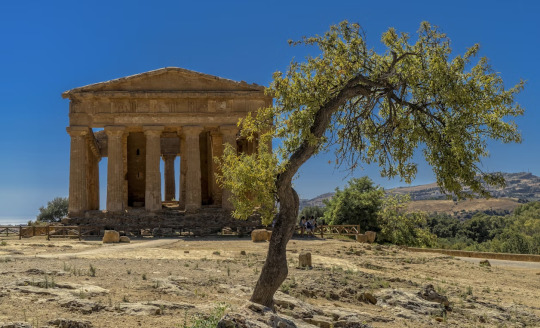
Valley of the Temples, Agrigento, Sicily, Italy
Ricardo Gomez Angel
1 note
·
View note
Text
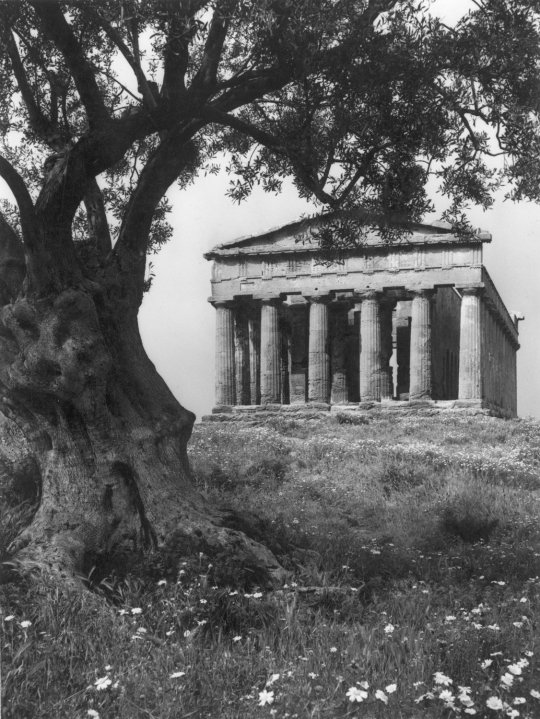
'Tempio della Concordia,' 1955,
Valley of the Temples, Agrigento, Sicily, Italy,
Photo by Konrad Helbig
#art#history#design#style#sculpture#antiquity#architecture#temple#vintage photography#sicily#italy#konrad helbig#concordia#agrigento#akragas
1K notes
·
View notes
Text

Valley of the Temples, is an archaeological site in Agrigento, #Sicily UNESCO World Heritage Site
72 notes
·
View notes
Text
📍Temple of Juno,Agrigento,Italy 🇮🇹
The temple of Juno in the Valley of the Temples, also known as Temple D, was built on the highest part of the ancient Greek city of Akragas (today’s Agrigento) around the mid-5th century BC.
It was dedicated to the Greek goddess Hera (Juno), protector of fertility and procreation; in fact the main ceremonies that took place inside were marriage unions.
The Temple is in Doric style and has a colonnaded perimeter (peripter), with six columns on the short sides (hexastyle) and 13 on the long sides. During the Carthaginian siege of Akragas in 406 BC, the structure was subjected to a fire, traces of which are still evident along the walls of the cell (naos).
It was then restored in Roman times.
@antiqua_archeologia
#travel #travelingare #dronephotography #architecture #ancient #italy #agrigento #akragas #sicily #valledeitempli #dorictemple #ancientgreek #archeology #archeologia
#lifestyle#myuploads#aesthetic#travel#travelingare#photography#architecture#drone photography#sicily#italy#agrigento#akragas#ancient greek#archeology
59 notes
·
View notes
Text
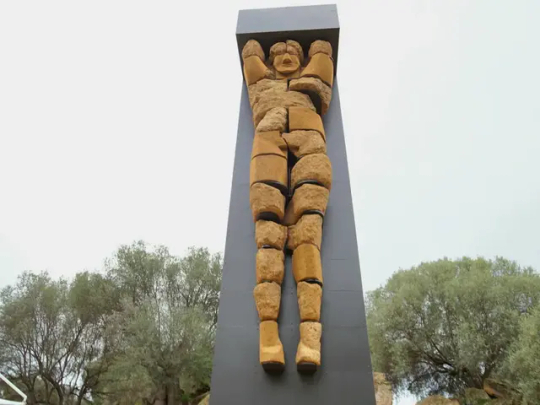
A Statue of Atlas Emerges From the Ruins of Sicily’s Ancient Temple of Zeus
In the fifth century B.C.E., 38 looming sculptures of the Titan stood guard at the structure.
After 20 years of restorations, a 26-foot-tall statue of Atlas is once again standing guard at the ancient Temple of Zeus in the city of Agrigento (once called Akragas) in Sicily.
The statue, created in the fifth century B.C.E., was one of roughly 38 similar Atlas monuments built into the temple. They stood in a line between columns with their arms raised, appearing to hold the holy structure upright.
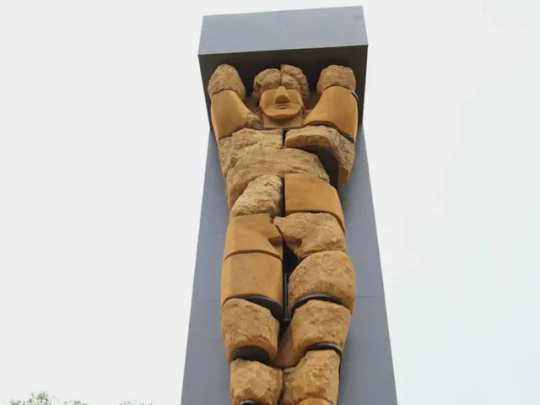
In Greek mythology, Atlas was a Titan who rebelled in a war against Zeus. As punishment, he was forced to hold up the sky on his shoulders. Unlike the mythological Atlas, however, the stone likenesses were unable to hold up Zeus’ temple forever. Ultimately, earthquakes and other events caused the structure to crumble.
For many years, pieces of the statues were scattered around the site amongst other ancient ruins. In 1812, Charles Robert Cockerell, a prominent British architect, first identified one of the Titan’s giant sandstone heads during a visit to Agrigento. A century later, in 1920, archaeologist Pirro Marconi became the first person to attempt to reconstruct one of the Atlases, which is now housed in the Archaeological Museum of Agrigento.
The seeds of the current project began in 2004, when the Valley of the Temples park conducted a sweeping research campaign at the site. Experts cataloged 90 fragments from at least eight Atlas statues.
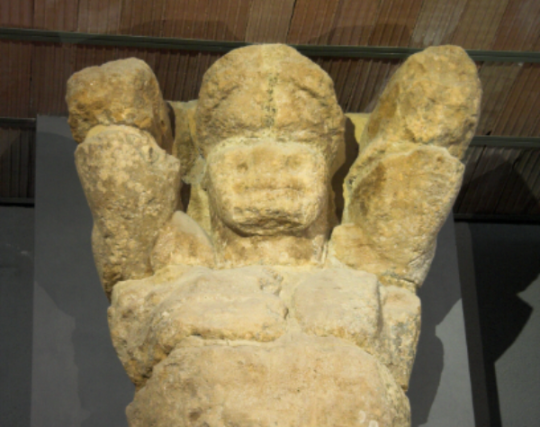
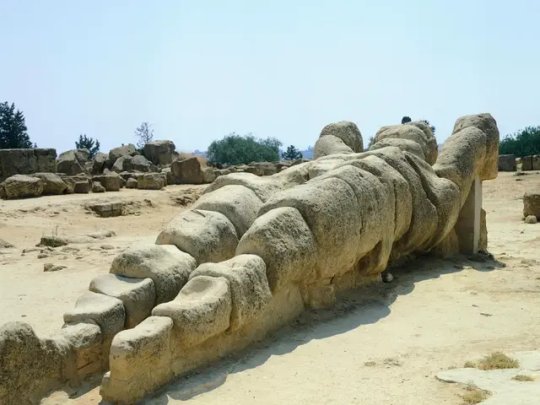

“The idea was to reposition one of these Atlases in front of the temple so that it may serve as a guardian of the structure dedicated to the father of the gods,” Roberto Sciarratta, the director of the Valley of the Temples park, tells the Guardian’s Lorenzo Tondo.
But rebuilding Atlas in a standing position was particularly challenging, as researchers couldn’t simply stack the pieces of the statue on top of one another. Instead, they attached the fragments to metal shelves, which are supported by a larger metal structure.
The restoration has faced scrutiny ever since officials first announced it several years ago.
“No archaeologist would endorse the use of ancient sculpture, no matter how fragmentary, to create a modern sculpture, even if the purpose is to highlight the site’s antiquity,” C. Brian Rose, an archaeologist at the University of Pennsylvania, told the New York Times’ Franz Lidz in 2020.
But officials like Renato Schifani, the Sicilian governor, think that the statue’s resurrection is a commendable feat.
“Today is an important day for Agrigento and for all of Sicily,” says Schifani in a statement, per Google Translate. “This stone giant of ancient Akragas, which after many years of studies and research we can observe in its natural position, is the heart of an important museum project of the entire area of the Temple of Zeus."
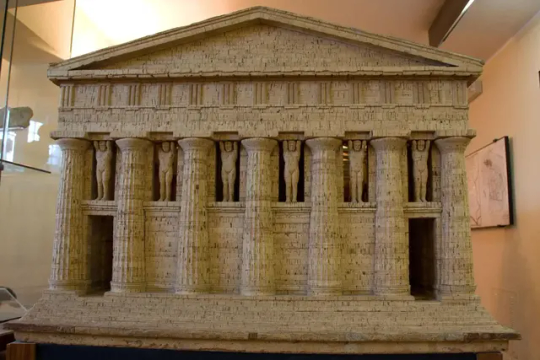
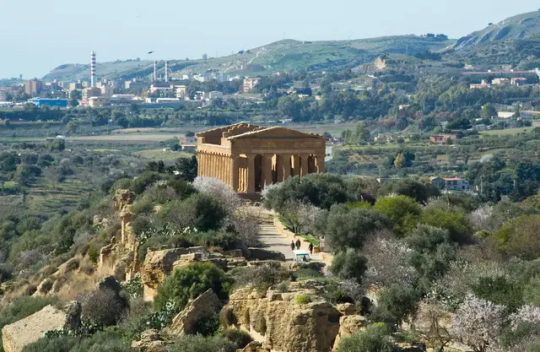
By Julia Binswanger.
#A Statue of Atlas Emerges From the Ruins of Sicily’s Ancient Temple of Zeus#Akragas#Agrigento#Sicily#Valley of the Temples park#temple#Temple of Zeus#ancient artifacts#archeology#archeolgst#history#history news#ancient history#ancient culture#ancient civilizations#roman history#roman empire#greek mythology
75 notes
·
View notes
Text

Temple of Juno (Hera), dating to around 450 BCE.
Valley of the Temples
Agrigento, Sicily
Dec. 2019
Explore:
#valley of the temples#agrigento#ancient greece#ancient greek#magna grecia#italia#italy#travel#original photography#photographers on tumblr#photography#lensblr#architecture#historical architecture#ancient architecture#temple#ancient temple#archaeology#sicily#sicilia#architettura#architecture photography#wanderingjana
15 notes
·
View notes
Text



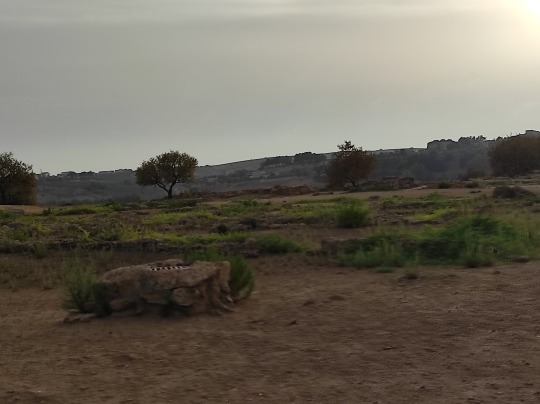
Last week I visited the Archeological area of Agrigento in Sicily.
In the valley of temples there is an ancient spot dedicated to the chthonic cult of Demeter and Persephone. The area, located near the Gate V, was used to celebrate the Thesmophoria, the ancient women celebration of fertility in honor of Demeter and Persephone.
The area is formed by remains of the temple dedicated to the chthonic deities and the ancient gate from which women entered the sanctuary to gather in the celebration of Thesmophoria. Near the temple there are wells and passages leading to underground caves where the worshippers threw their offerings, including piglets used in the festivities in honor of Demeter and kore.
Within the Agrigento area there are two other sites (that I couldn’t visit) dedicated to the worship of Demeter and Persephone located on the slopes of the Athenian cliff (Rupe Atenea). These are the ancient temple of Demeter, later converted into a church dedicated to St. Biagio, and an older rock sanctuary of pre-Greek origin. The sanctuary, completely excavated within the hill, was probably used by indigenous pre-Greek peoples and was dedicated to a fertility deity later assimilated to Demeter or a nymph cult.
#witchcraft#witchblr#paganism#witches of tumblr#pagan witch#hellenic pagan#hellenic polytheism#hellenic worship#Thesmophoria#archaeology#demeter and kore#greek temple#ancient religions#history#my pics#italianwitch#strega
28 notes
·
View notes
Text
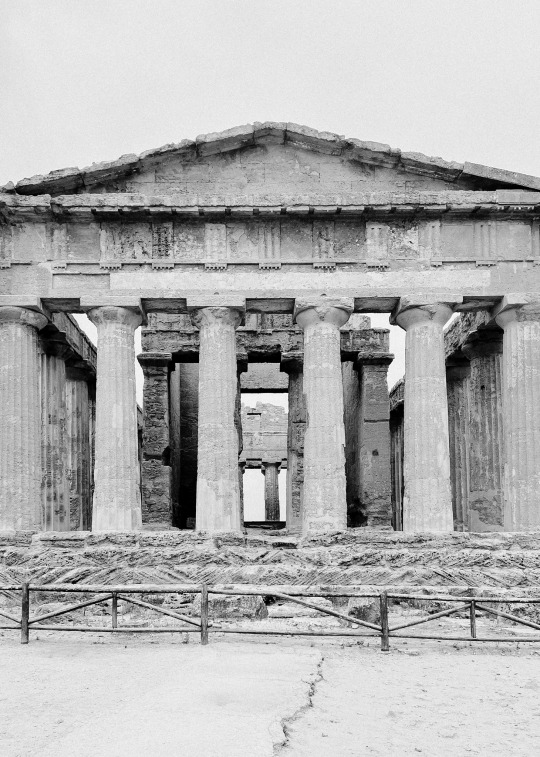
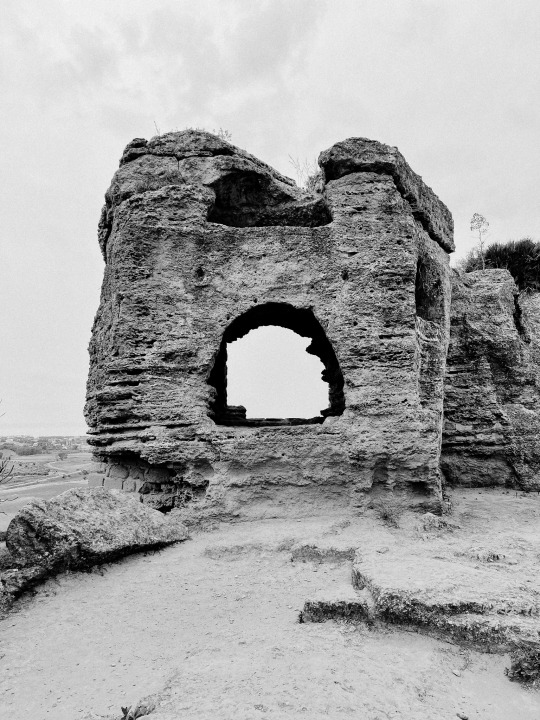


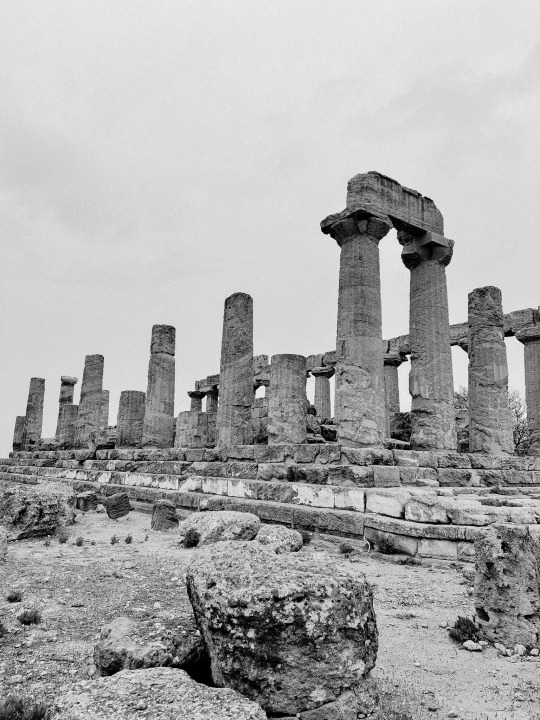
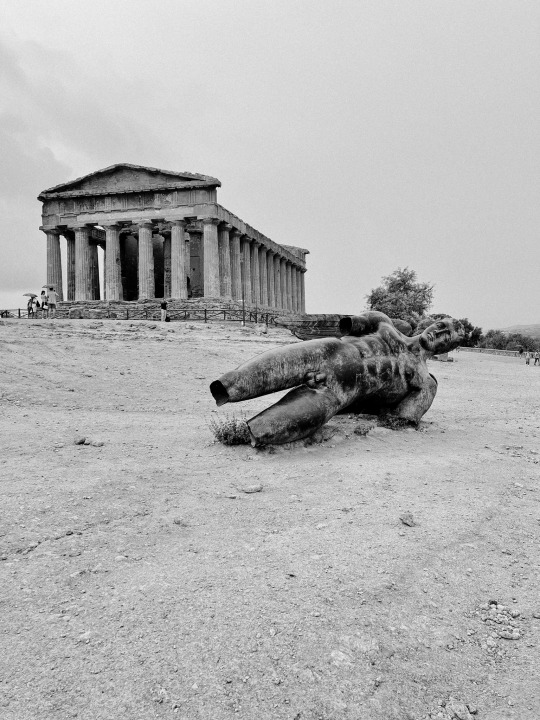
Valley of the Temples - Agrigento, Italy 🏛️
#valley of the temples#sicily#italy#that was also beautiful#my boyfriend gave me a private tour because he’s an archeologist and knows everything about this place 🖤#BLESSED
10 notes
·
View notes
Text

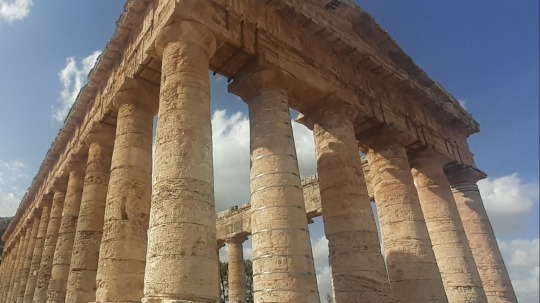

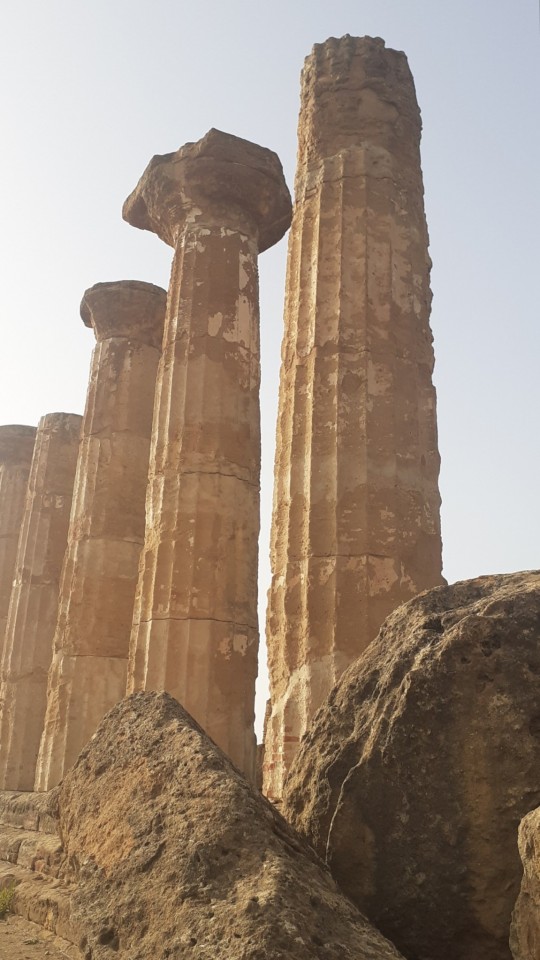

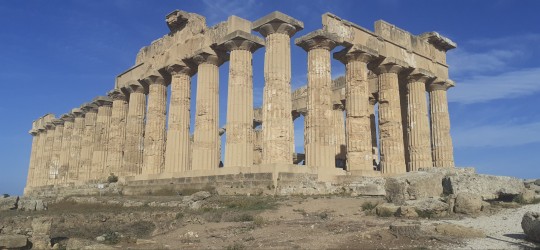
Valley of the Temples, Agrigento, Sicilia.
#classical studies#ancient greece#latin#greek mythology#greek gods#temples#archeology#travel#sicilia#dark academia#light academia#ancient history
9 notes
·
View notes
Text
Heritage News of the Week
Discoveries!
Archaeologists in China have unearthed hundreds of tombs and relics, including several bronze swords, dating from the Warring States period more than 2,200 years ago.
Baptismal font from the Ottonian period discovered: Oldest evidence of a quatrefoil-shaped basin north of the Alps
The site of a font of the medieval Ottonian dynasty, from the tenth century, has been discovered in the crypt of St Servatii’s Collegiate Church, Quedlinburg, in Germany. Archaeologists believe that it could be the oldest evidence of a four-passage font — with four arches — north of the Alps.
Archaeologists find an assemblage of petroglyphs alongside dinosaur tracks in Brazil
A recent study, published in the journal scientific reports, reveals that the outcrops have fossilised footprints from the Early Cretaceous Period, left behind by theropods, sauropods, and iguanodontian dinosaurs.
Dozens of Neolithic burials and 'sacrificed' urns and ax discovered in France
Archaeologists in France have excavated a Neolithic site containing 63 burials and hundreds of structures and artifacts from a human occupation spanning roughly 4,000 years.
Archaeologists unearth new building in Sicily’s Valley of the Temples
A previously unknown building has been identified by archaeologists working in Sicily’s Valley of the Temples in Agrigento, Italy, according to a new study published in the Journal of Archaeological Science: Reports. The structure may have been part of religious practices in the ancient city.
Hidden tunnel complex from Bar Kokhba Revolt found near Sea of Galilee
The tunnel complex was found at Huqoq near the Sea of Galilee and was revealed to originally be a water cistern from the Second Temple. During the Bar Kokhba Revolt, the inhabitants of Huqoq dug a series of tunnels from the cistern that connected to eight underground chambers and a mikveh.
2,000-year old bronze wares found in Shanxi Province
Archaeologists have uncovered 2,000-year old bronze wares during excavations of the Taosi North Cemetery in Shanxi Province. In a press statement by the Shanxi Provincial Institute of Archaeology, the cemetery was discovered due to illegal excavations by tomb robbers in 2014.
Thousand-year-old bone skate discovered in Czech Republic
Archaeologists from the central Moravian city of Přerov, Czech Republic have announced a unique discovery. While carrying out excavations in the center of the town, they found an ice skate made of animal bone dating back some 1,000 years.
Obsidian blades with food traces reveal first settlers of Rapa Nui had regular contact with South Americans 1,000 years ago
The earliest settlers of Rapa Nui, also known as Easter Island, appear to have had some sort of contact with people from South America as early as 1,000 years ago, a new plant study finds.
Rare medieval belt loop found near Kamień Pomorski
An extremely rare medieval belt loop has been found near Kamień Pomorski in Poland’s West Pomeranian Voivodeship. According to the Museum of the History of the Kamieńska Land, the discovery represents one of only 15 similar belt loops ever found in Europe.
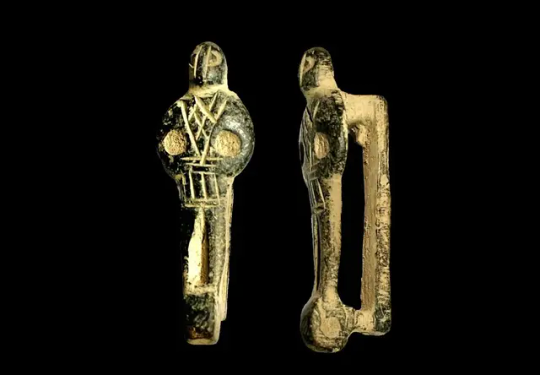
It's a little skull!
7,000-year-old canoes from Italy are the oldest ever found in the Mediterranean
Five canoes found at the bottom of a lake in Italy were used more than 7,000 years ago for fishing and transport by people living in a Neolithic village near what is now Rome. Archaeologists to excavate Sheffield Castle where Mary, Queen of Scots was imprisoned
Archaeologists recover Aztec Codices of San Andrés Tetepilco
The three codices date from the late 16th to early 17th century and are believed to be a continuation of the Boturini Codex.
Archaeologists to excavate Sheffield Castle where Mary, Queen of Scots was imprisoned
Throughout April and May of 2024, archaeologists from Wessex Archaeology will be conducting a series of excavations to uncover and preserve the foundations of the circular towers of the castle’s gatehouse, and explore the destruction deposits from the razing of the original motte and bailey castle by John D’Eyvill in the 13th century.
Scientists reconstruct face of 16th century Italian ‘vampire’ buried with brick in mouth
A facial reconstruction expert reconstructed the features of the female corpse discovered in a mass grave of plague victims on the Venetian island of Lazzaretto Nuovo. Brazilian forensic expert and 3D illustrator Cícero Moraes applied features to the woman, who was unearthed in an archaeological dig in 2006.
Excavations at Dahshur have recently uncovered a mudbrick built mastaba and reliefs that belonged to an individual named neb-neb-af and his wife Idut, who lived during the late 5th and early 6th dynasty.
Museums
A bronze age settlement built on stilts that dropped “like a coffee plunger” into a river after a catastrophic fire has provided a window on our past lives, according to the archaeologist that led the investigation of the Cambridgeshire site. On Wednesday, two open-access publications are being launched that comprehensively detail the finds from the excavation at a working brick clay quarry. Next month, some of the preserved objects will go on display at Peterborough Museum in an exhibition that tells the story of bronze age life in the short-lived settlement and its discovery almost 3,000 years later.
Louvre receives bomb threat targeting ‘Mona Lisa’
The threat, written in English, was sent via the museum’s website and reportedly signed by “Pères fondateurs de la Confederation” (Founding Fathers of the Confederation). According to a police source, on Wednesday, Louvre leadership filed a complaint, citing a “threat of attack.” The museum later confirmed the incident to the French news outlet.
Repatriation
Special agent Geoffrey J. Kelly, from the FBI Boston field office, was notified about a trove of Asian art in a private residence in January 2023, the FBI said. The residence was previously owned by a World War II veteran who the FBI said had died. Family members found the works while going through their father’s estate.
Denver Art Museum repatriates Vietnamese artifact tied to disgraced donor
The Denver Art Museum (DAM) is repatriating an ancient artifact it deaccessioned last year to Vietnam following a claim from the country’s officials that flagged its origins. The bronze dagger, dated between 300 BCE and 200 CE, is believed to have been produced in the former Dong Son region in the country’s north. Its return is connected to an ongoing probe by US and foreign officials into works held in the Colorado museum’s collection that have ties to Emma C. Bunker, an art historian who died in 2021 and who had sat on the museum’s board.
The curse of Douglas Latchford strikes yet again
Metropolitan Museum of Art hires its first provenance research head
New York’s Metropolitan Museum of Art has named Sotheby’s executive Lucian Simmons to the newly created head of provenance research.
Odds and ends
At the MacDill Air Force Base in Tampa, Florida, the location of a Black cemetery has been confirmed through a non-intrusive archaeological survey. So far, 121 potential graves have been identified, with the survey, which involves ground-penetrating radar, still ongoing.
New life for the Sycamore Gap tree
To create a lasting legacy for the Sycamore Gap Tree, the National Trust took seeds and cuttings to their Plant Conservation Centre. In a press statement issued by the National Trust: “Several dozen seeds are now sprouting, having been planted in specially tested peat-free compost. We’ve also been using a variety of propagation methods to create genetically identical replicas of the tree.”
‘Holy grail of shipwrecks’: recovery of 18th-century Spanish ship could begin in April
Since the Colombian navy discovered the final resting place of the Spanish galleon San José in 2015, its location has remained a state secret, the wreck – and its precious cargo – left deep under the waters of the Caribbean. Efforts to conserve the ship and recover its precious cargo have been caught up in a complicated string of international legal disputes, with Colombia, Spain, Bolivian Indigenous groups and a US salvage company laying claim to the wreck, and the gold, silver and emeralds onboard thought to be worth as much as $17bn.
Scientists find skull of enormous ancient dolphin in Amazon
Scientists have discovered the fossilised skull of a giant river dolphin, from a species thought to have fled the ocean and sought refuge in Peru’s Amazonian rivers 16m years ago. The extinct species would have measured up to 3.5 metres long, making it the largest river dolphin ever found.
Scientists name newly discovered ancient amphibian species after Kermit the Frog
Scientists have discovered a species of an ancient amphibian ancestor, which they have named Kermitops gratus because of its resemblance to the bright green star of The Muppet Show.

18 notes
·
View notes